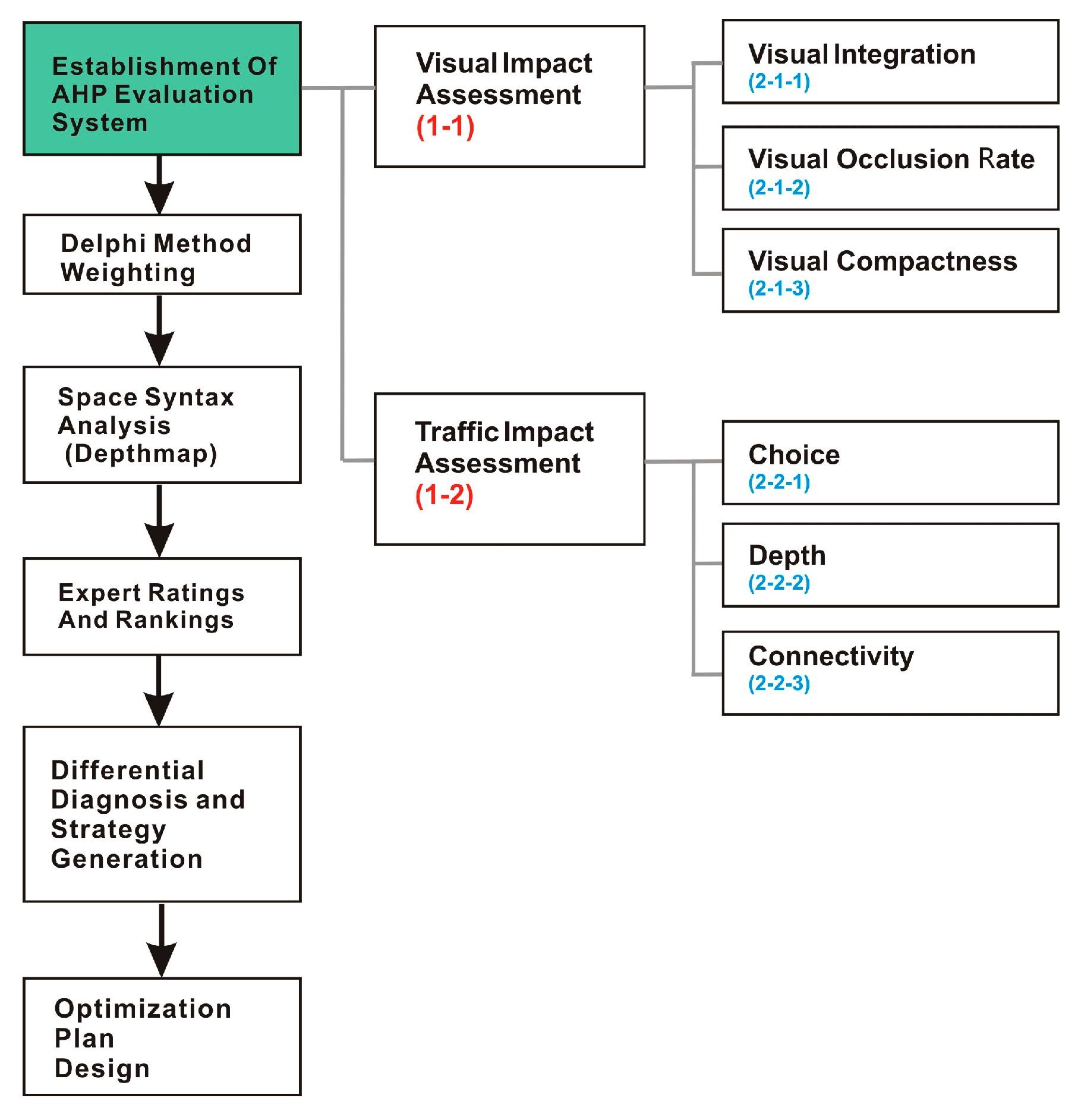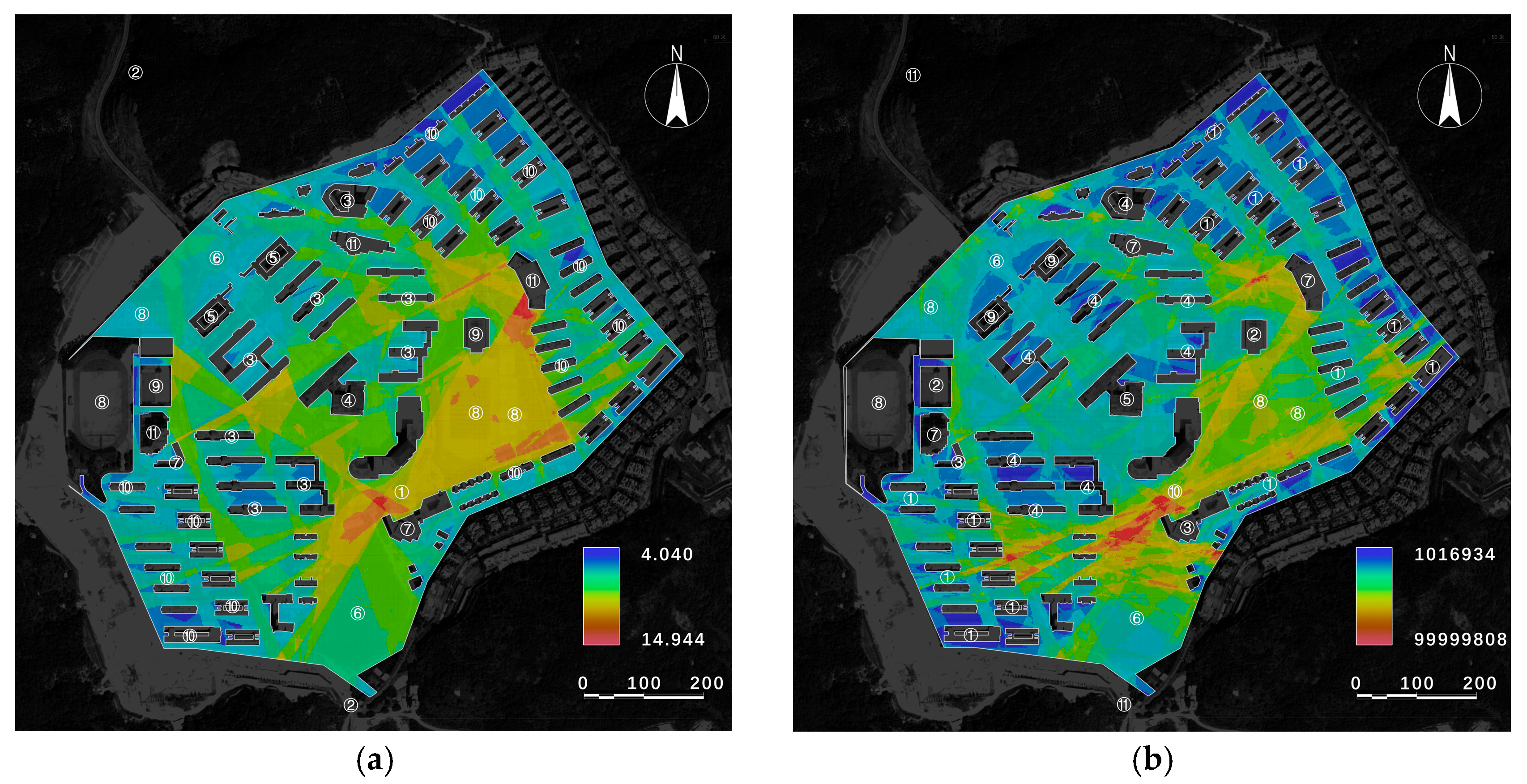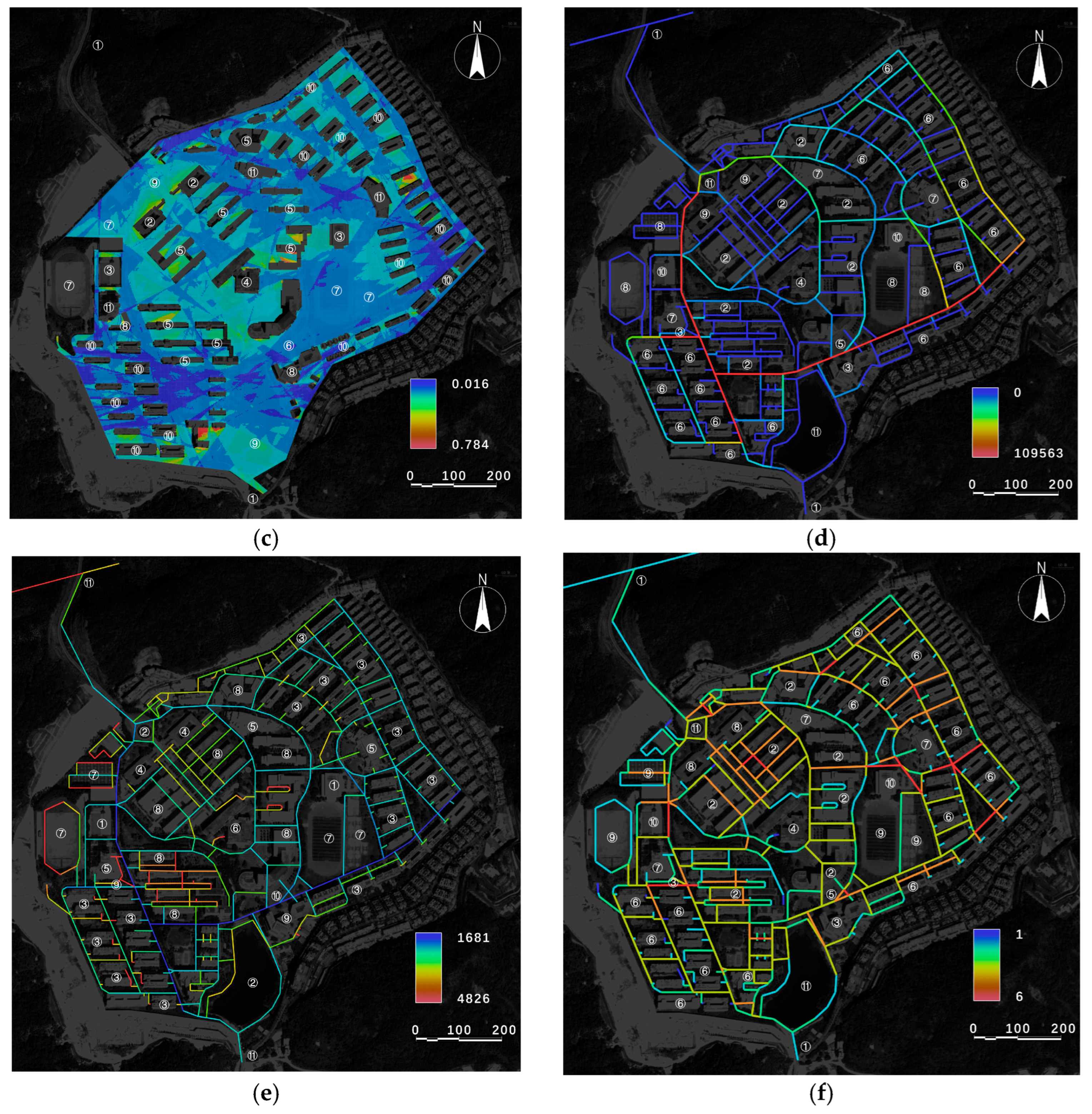Identification and Optimization of Components of University Campus Space †
Abstract
1. Introduction
2. Literature Review
3. Research Methods
- Visual integration: This metric was used to quantify a viewpoint to connect the global visual network to visual accessibility and penetration efficiency. Areas with high visual integration serve as visual focal points, while low-value areas become spatial blind spots. Visual integration was used to identify the components of the campus, such as enclosed squares or obscured building entrances, that lack visual appeal, as shown in Figure 2a.
- Visual occlusion rate: This measures the proportion of visual lines blocked by physical obstacles within a specific area. The rate was calculated by determining the ratio of invisible areas to the whole visual field. This metric was used to identify campus areas with poor visual permeability, as shown in Figure 2b.
- Visual compactness: This describes the degree of spatial aggregation within a given viewpoint’s visible range. The sense of enclosure and the directionality of spatial perception were quantified by calculating the compactness of the visible area’s geometric shape. This metric is crucial for evaluating the visual orientation of the campus’s core components, as shown in Figure 2c.
- Choice: This metric represents the probability of a spatial component being traversed within the path network. Choice was used to quantify the likelihood of a path selected by pedestrians as the shortest route, reflecting its intermediary characteristics and the efficiency and fairness of traffic organization. Based on shortest path calculations in a topological network, high-choice values are obtained as a transportation hub. Choice was used to analyze the traffic efficiency of main roads and branch roads across the campus, as shown in Figure 2d.
- Depth: The depth value indicates the minimum number of steps required to reach other spaces from an origin, representing the number of topological transitions from an entrance to a target component. It reflects the complexity of spatial accessibility, where a lower value signifies higher accessibility. Depth was used to identify areas on campus with poor accessibility, as shown in Figure 2e.
- Connectivity: This refers to the number of components directly connected to a given component, reflecting the degree of spatial networking and permeability. Based on topological adjacency statistics, a high connectivity value indicates that the component is a transportation hub. Connectivity was used to evaluate the permeability between different functional areas on campus, as shown in Figure 2f.
4. Results
4.1. Study Area
4.2. Administrative Building
4.3. Teaching Building
4.4. Library
4.5. Stadium
4.6. Gymnasium
4.7. Residence Hall
4.8. Dining Hall
4.9. Commercial District
4.10. Campus Gate
4.11. Square
4.12. Landscape Zone
- Visual guidance: implement sequential landscape elements, such as tree arrays and lamp posts, along the main road leading to the administrative building to create a clear visual guidance axis.
- Visual penetration: reduce the height of surrounding walls or replace them with open fences, and remove view-obstructing bushes while retaining tall trees.
- Facade recognition: utilize night lighting systems to emphasize building outlines, add the school logo to the roof, and employ contrasting color materials to highlight main entrances.
- Visual corridor: demarcate a 50 m radius visual protection zone centered on the administrative building, prohibiting new physical structures within this area.
- Spatial organization: relocate non-motorized vehicle parking to side roads and implement dynamic greening management by selectively thinning surrounding trees and replacing bottom vegetation with low perennial flowers.
- Signage system: install a dynamic light strip device at the highest point of buildings to create visible landmarks at night.
- Ecological buffer zones: plant deciduous trees along building perimeters to provide seasonal light and shadow filtering, thus creating a visual sense of hierarchy.
5. Conclusions
Author Contributions
Funding
Institutional Review Board Statement
Informed Consent Statement
Data Availability Statement
Conflicts of Interest
References
- Popoola, S.I.; Atayero, A.A.; Popoola, O.A. Comparative assessment of data obtained using empirical models for path loss predictions in a university campus environment. Data Brief. 2018, 18, 380–393. [Google Scholar] [CrossRef] [PubMed]
- Hajrasouliha, A.H. Master-planning the American campus: Goals, actions, and design strategies. Urban Des Int. 2017, 22, 363–381. [Google Scholar] [CrossRef]
- Ye, X.; Mansury, Y. Behavior-driven agent-based models of spatial systems. Ann. Reg. Sci. 2016, 57, 271–274. [Google Scholar] [CrossRef][Green Version]
- Cheng, J.; Yan, C. The Construction of High-quality Campus Learning Spaces: A Life-world Perspective. J. East China Norm. Univ. (Educ. Sci.) 2024, 42, 51–60. [Google Scholar][Green Version]
- Saaty, R.W. The analytic hierarchy process—What it is and how it is used. Math. Model. 1987, 9, 161–176. [Google Scholar] [CrossRef]
- Ishizaka, A.; Labib, A. Review of the main developments in the analytic hierarchy process. Expert Syst. Appl. 2011, 38, 14336–14345. [Google Scholar] [CrossRef]
- Liu, Y. Evaluation of University Campus Landscape Based on AHP: A Case Study of Southwest University of Science and Technology. Open Access Libr. J. 2021, 8, 1–11. [Google Scholar] [CrossRef]
- Hillier, B.; Hanson, J. The Social Logic of Space; Cambridge University Press: Cambridge, UK, 1984. [Google Scholar]
- Xiao, Y. Space Syntax Methodology Review. Urban Morphology and Housing Market. Springer Geography; Springer: Singapore, 2017. [Google Scholar]
- Yaylali-Yildiz, B.; Spierings, B.; Çil, E. The spatial configuration and publicness of the university campus: Interaction, discovery, and display on De Uithof in Utrecht. Urban Des. Int. 2022, 27, 80–94. [Google Scholar] [CrossRef]
- Tomko, M.; Winter, S. Describing the functional spatial structure of urban environments. Comput. Environ. Urban Syst. 2013, 41, 177–187. [Google Scholar] [CrossRef]
- Zhou, Y.; Wang, Y.; Jin, H. Research on the restorative benefits of campus green space under visual and olfactory perception. Chin. Gard. 2023, 39, 36–41. [Google Scholar]
- Wang, T.; Sun, S.; Liu, N.; Chen, Y.; Zheng, L. Quantifying University Campus Imagery: A Social Survey of Three University Campuses in China based on Internet Image Data. In Proceedings of the 2024 International Conference on Digital Society and Artificial Intelligence, Qingdao, China, 24–26 May 2024; pp. 441–450. [Google Scholar]
- Zhang, X.; Song, J.; Peng, J.; Wu, J. Landslides-oriented urban disaster resilience assessment—A case study in Shenzhen, China. Sci. Total Environ. 2019, 661, 95–106. [Google Scholar] [CrossRef] [PubMed]
- Li, J.; Lu, Y. Research on campus spatial structure based on Depthmap. Urban Archit. 2025, 22, 34–38. [Google Scholar]



| Visual impact assessment (1-1) −0.625 | Visual Integration (2-1-1) −0.540 | 0.337 | 1 |
| Visual Occlusion Rate (2-1-2) −0.297 | 0.186 | 2 | |
| Visual Compactness (2-1-3) −0.163 | 0.102 | 5 | |
| Traffic impact assessment (1-2) −0.375 | Choice (2-2-1) −0.490 | 0.184 | 3 |
| Depth (2-2-2) −0.312 | 0.117 | 4 | |
| Connectivity (2-2-3) −0.198 | 0.074 | 6 | |
| Total weighting value (Level 1 × 2) − ωi | 1.00 | ||
| Remark |
| ||
| Visual Integration | Visual Occlusion Rate | Visual Compactness | Choice | Depth | Connectivity |
|---|---|---|---|---|---|
| Square (6.8) | Residence Hall (6.2) | Campus Gate (6.4) | Campus Gate (6.7) | Gymnasium (6.1) | Campus Gate (6.9) |
| Campus Gate (6.5) | Gymnasium (5.8) | Administrative Building (6.1) | Teaching Building (6.3) | Landscape Zone (5.8) | Teaching Building (6.5) |
| Teaching Building (5.9) | Commercial District (5.5) | Gymnasium (5.7) | Commercial District (5.9) | Residence Hall (5.5) | Commercial District (6.2) |
| Library (5.7) | Teaching Building (4.7) | Library (5.3) | Library (5.6) | Administrative Building (5.2) | Library (5.8) |
| Administrative Building (5.3) | Library (4.3) | Teaching Building (4.9) | Square (5.2) | Dining Hall (4.9) | Square (5.4) |
| Landscape Zone (4.8) | Landscape Zone (3.9) | Square (4.6) | Residence Hall (4.8) | Library (4.6) | Residence Hall (5.1) |
| Commercial District (4.5) | Dining Hall (3.5) | Stadium (4.2) | Dining Hall (4.5) | Stadium (4.3) | Dining Hall (4.7) |
| Stadium (4.1) | Stadium (3.1) | Commercial District (3.8) | Stadium (4.1) | Teaching Building (3.8) | Administrative Building (4.3) |
| Gymnasium (3.9) | Administrative Building (2.8) | Landscape Zone (3.5) | Administrative Building (3.7) | Commercial District (3.5) | Stadium (3.9) |
| Residence Hall (3.2) | Square (2.3) | Residence Hall (3.1) | Gymnasium (3.3) | Square (3.1) | Gymnasium (3.6) |
| Dining Hall (2.8) | Campus Gate (1.9) | Dining Hall (2.7) | Landscape Zone (2.9) | Campus Gate (2.7) | Landscape Zone (3.2) |
Disclaimer/Publisher’s Note: The statements, opinions and data contained in all publications are solely those of the individual author(s) and contributor(s) and not of MDPI and/or the editor(s). MDPI and/or the editor(s) disclaim responsibility for any injury to people or property resulting from any ideas, methods, instructions or products referred to in the content. |
© 2025 by the authors. Licensee MDPI, Basel, Switzerland. This article is an open access article distributed under the terms and conditions of the Creative Commons Attribution (CC BY) license (https://creativecommons.org/licenses/by/4.0/).
Share and Cite
Sun, Y.; Ouyang, Y. Identification and Optimization of Components of University Campus Space. Eng. Proc. 2025, 108, 33. https://doi.org/10.3390/engproc2025108033
Sun Y, Ouyang Y. Identification and Optimization of Components of University Campus Space. Engineering Proceedings. 2025; 108(1):33. https://doi.org/10.3390/engproc2025108033
Chicago/Turabian StyleSun, Yue, and Yifei Ouyang. 2025. "Identification and Optimization of Components of University Campus Space" Engineering Proceedings 108, no. 1: 33. https://doi.org/10.3390/engproc2025108033
APA StyleSun, Y., & Ouyang, Y. (2025). Identification and Optimization of Components of University Campus Space. Engineering Proceedings, 108(1), 33. https://doi.org/10.3390/engproc2025108033






